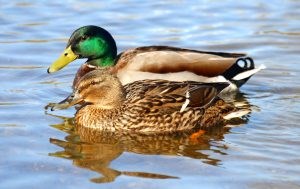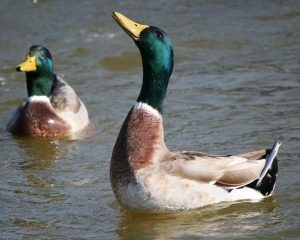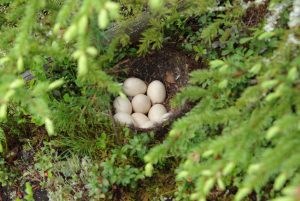This content was originally published by the Longmont Observer and is licensed under a Creative Commons license.
One of the most common birds at ponds and parks is the mallard. The mallard has given rise to specific populations that are now considered a subspecies or a species in its own right, such as the Hawaiian Duck. This duck is the ancestor of all the domestic ducks except for the Muscovy duck. This can sometimes make identification confusing as domestic ducks that have escaped captivity can show up in local ponds and parks. In addition, the mallard is known to interbreed with several other duck species such as teal, gadwall, and pintails which makes for some interesting hybrids.
The mallard is one of the easier ducks to identify, with the male being readily identifiable. They are relatively large ducks, being between a crow and a goose in size. Mallards vary in length being 19-26 inches in length. They weigh two to three pounds and have a wingspan of 32-37 inches.
Males have an iridescent green head with a bright yellow bill. The majority of the body is brown with a black rear. The wing has a blue patch bordered in white called a speculum or wing patch.
Females and juveniles are a bit trickier to identify, but their size is a good clue as to what species you are dealing with. Females and juveniles are a mottled brown all over with the blue wing patch that is bordered in white.

Mallards occur in both natural and artificial wetland habitats. They can be found on lakes, ponds, rivers, marshes, and coastal habitats. As mentioned, they are common in the city as well wherever water can be found. Mallards have been known to show up in backyards with swimming pools. The water source does not have to be present year-round for mallards to exist in an area. In addition to wetland habitats, you can sometimes find mallards feeding along roadsides, pastures, and crop fields.
Mallards eat a wide variety of foods and are considered generalist feeders. Rather than diving for their food, mallards are dabbling ducks. When they dabble, they tip their body forward, leaving their rump up in the air. This allows them to reach seeds and aquatic vegetation. They also eat vegetation along the shoreline. During the breeding season, mallards eat primarily aquatic insect larvae, earthworms, snails, and freshwater shrimp. In contrast, they eat primarily agricultural seed and grain during migration. Of course, mallards will also readily take food from humans at parks.
You should know that it may actually be illegal to feed waterfowl in the park and it is not healthy for the ducks. Often, people feed birds things that their bodies are not designed to digest. Bread has no real nutritional value and mallards may fill up on it rather than eating food that is nutritious for them. In addition, bread that does not get eaten can fall to the bottom of the pond and if enough accumulates, can cause an algae bloom. Moldy bread on the ground is dangerous for mallards as it can cause fatal lung disease if consumed.
Getting mallards accustomed to being fed by humans in the park can also cause them to congregate in large numbers. Overcrowding can lead to disease. Mallards may also delay migration in the fall if they are getting free handouts and may fail to teach their young how to forage properly.

Duck pairs actually form in the fall prior to breeding season. Courtship displays can be seen throughout the fall and winter. The male will dip his bill in the water, then rise up giving whistle and grunt calls as he settles back into the water. He may also raise his head and tail while giving a sharp call or he may submerge the forepart of his body in the water and fling water with his bill as he emerges.
The female responds to the male by nodding her head back and forth and swimming with her head held low. Although pairs are usually monogamous during the breeding season, extra-pair copulations do occur. Commonly, several males will surround a female vying for her attention. Males may forcibly mate with a female.
The mallard pair searches for a nest site together and will choose a nest site that is close to water, although in some cases nests can be located up to a mile from water. The nest is usually hidden by overhanging vegetation.
Mallards will readily use artificial nest boxes. Occasionally, the nest may be situated on a floating mat of vegetation. Once the nest site is chosen, the female creates a shallow depression in the ground. Rather than carrying nesting material to the nest, the female will pull surrounding vegetation into the nest as she is sitting in it.
Once incubation begins, the female pulls feathers from her breast to help line the nest and cover the eggs. The finished nest is about a foot across with the actual bowl of the nest being one and six inches deep and six to nine inches across.

The female lays between one and 13 eggs with the average being between seven and ten eggs. The incubation period lasts between 26-30 days and all incubation is done by the female. The young are born feathered and ready to go (precocial) and will leave the nest within 24 hours of hatching. The female will lead the ducklings to water where they will feed themselves as they are tended to by the female. Ducklings are capable of flying about 60 days after hatching. Mallards typically only have one brood per year.
There are plenty of mallards about town, so you are sure to spot ducklings soon on one of the local ponds or lakes. When you do, take a few minutes to appreciate how remarkable it is that ducklings are able to care for themselves so quickly after hatching. You are also likely to hear the characteristic quacking of the female duck, so keep your ears and eyes peeled.


